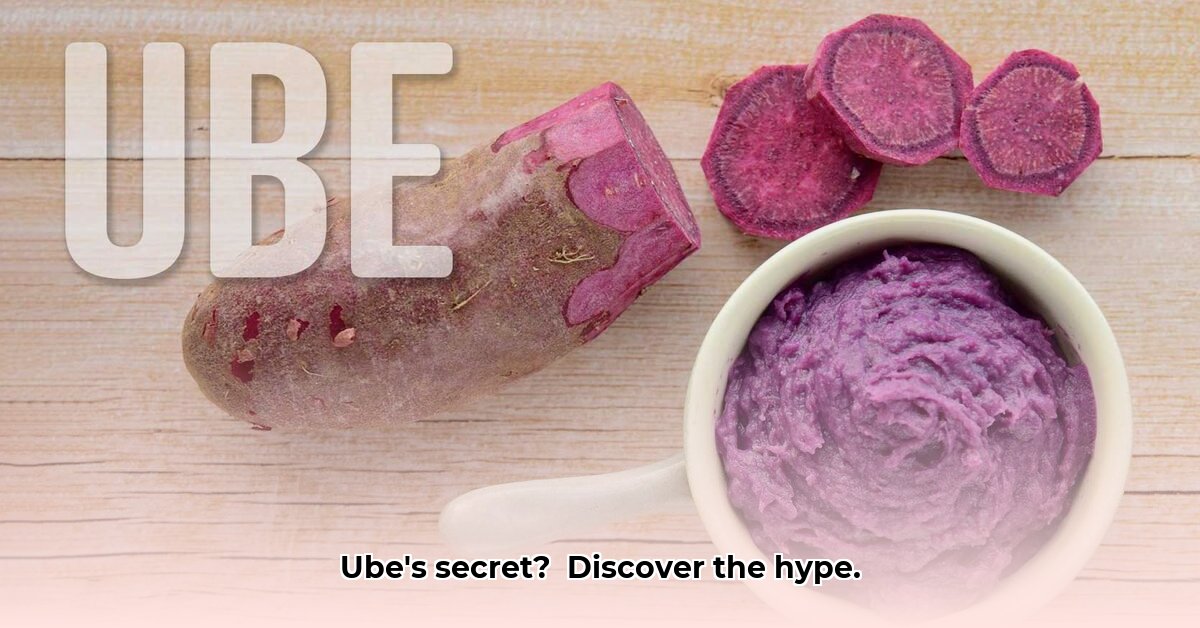Purple ube, once a relatively obscure ingredient, has surged onto the global culinary landscape. This report examines ube’s expanding journey, from its cultural origins to its explosion in popularity, offering insights for food businesses seeking to capitalize on this exciting market. We’ll explore successful strategies, analyze competitive landscapes, and offer future-proof approaches for sustained success in the ube craze.
Food That Starts With U: A Deep Dive into Culinary Trends
Ube, the vibrant purple yam, has captured the attention of chefs, foodies, and home cooks alike. Its unique, subtly sweet flavor, reminiscent of vanilla with hints of pistachio, and its striking purple color have fueled its incorporation into a vast array of culinary creations, from ice cream and cakes to savory dishes. But is ube’s popularity a fleeting trend, or does it represent a more enduring shift in culinary preferences?
The truth lies in ube’s remarkable versatility and cultural significance. Its adaptability to both sweet and savory applications sets it apart, contributing to its widespread appeal. Furthermore, its deep roots in Filipino culture provide a compelling narrative that resonates with consumers seeking authentic and unique food experiences.
Beyond Ube: Exploring the Global Culinary Alphabet
While ube currently dominates the “U” food scene in terms of trendiness, the global culinary landscape offers a diverse array of other intriguing dishes that begin with the letter “U.” Ugali, a dense cornmeal porridge, is a staple food in many parts of Africa, representing enduring cultural significance and nutritional sustenance. Uborkasaláta, a refreshing Hungarian cucumber salad, provides a glimpse into Eastern European cuisine, while Ugba, fermented oil bean from Igbo culture in Nigeria, showcases the unique flavors of West Africa.
These diverse dishes present opportunities for niche food businesses to explore specific culinary traditions and create unique and authentic products. How might smaller food businesses leverage this diversity to cater to specific markets and create innovative products that celebrate global culinary heritage?
Market Snapshot: Ube’s Rocket Ride vs. Ugali’s Steady Climb
Comparing the market dynamics of ube and ugali reveals contrasting paths to market success, each with its own set of opportunities and challenges:
| Food Item | Trend | Market Potential | Key Challenges |
|---|---|---|---|
| Ube | Explosively growing | Very High | Maintaining supply chain integrity, managing rapidly increasing demand, avoiding market saturation, ensuring authentic cultural representation |
| Ugali | Stable, consistent | Moderate | Expanding global appeal beyond diaspora communities, modernizing production and distribution, addressing potential health concerns related to maize processing and nutritional value |
Ube’s immense potential requires careful management of supply chains to ensure consistent quality and ethical sourcing, as well as proactive strategies to manage consumer expectations and avoid the pitfalls of over-saturation. Conversely, ugali, while possessing a smaller, more stable market, offers opportunities for targeted marketing campaigns that highlight its cultural significance and nutritional benefits.
Who Benefits? The Future of “U” Foods
Strategic navigation of the “U” food market holds the potential to benefit a wide range of stakeholders, fostering innovation, sustainability, and cultural exchange:
- Ube Businesses: Focus on innovation by developing new and exciting ube-based products, ensure sustainable sourcing practices to protect the environment and support local communities, and diversify product lines to cater to evolving consumer preferences and ensure long-term growth.
- Ugali Producers: Modernize production techniques to improve efficiency and consistency, enhance distribution networks to reach new markets, and develop value-added products, such as pre-packaged ugali mixes or ready-to-eat ugali meals, to appeal to modern consumers.
- Retailers: Embrace cultural diversity by offering a wide range of “U” foods, catering to diverse tastes and dietary preferences, and highlighting the unique stories and cultural significance of each product.
- Food Scientists and Researchers: Invest in research to better understand the health benefits, sustainability aspects, and market size of “U” foods, providing valuable insights for businesses and consumers alike.
By fostering a deeper understanding of market trends and dynamics, we can celebrate culinary heritage, promote sustainable food systems, and create exciting market opportunities that benefit all stakeholders.
Determining Market Size for Niche Ube-Based Food Products
Accurately determining the market size for niche ube-based food products is a crucial step in transforming a delicious trend into a sustainable and profitable business venture. This process requires a combination of strategic market analysis, data-driven insights, and a clear understanding of your target audience.
Defining Your Niche
Begin by clearly defining your specific ube product offering. Are you specializing in ube ice cream, focusing on baked goods infused with ube, or creating a completely unique and innovative ube-based product? The level of specificity in defining your niche will directly influence the accuracy and relevance of your market analysis. For example, the market analysis approach for vegan ube mochi will differ significantly from that of a general ube cake product.
Methods for Market Sizing
Utilize a combination of the following methods to estimate the market size for your ube product:
- Top-Down Approach: Begin with the broader dessert or snack market and then estimate the specific share that your ube product can realistically capture based on current market trends, competitive analysis, and unique selling propositions.
- Bottom-Up Approach: Estimate potential demand by carefully evaluating your target customer base, assessing their willingness to purchase your product at a specific price point, and projecting sales volume based on realistic market penetration rates.
- Value Theory Approach: Assess the unique value proposition of your ube product, quantify the benefits it offers to consumers (e.g., unique flavor, health benefits, cultural appeal), and estimate market size based on consumer willingness to pay for those specific benefits.
Combining these three approaches will provide a more comprehensive and reliable estimate of your potential market size.
Data Sources
Gather relevant data from a variety of reliable sources:
- Market Research Reports: Leverage industry-specific market research reports to gain insights into current market trends, consumer preferences, competitor analysis, and overall market growth forecasts.
- Government and Industry Data: Utilize statistical agencies and industry associations to access publicly available datasets on food consumption patterns, demographic trends, and economic indicators relevant to your target market.
- Social Media Analytics: Monitor social media platforms to track mentions, hashtags, and online conversations related to ube and similar products, gaining valuable insights into consumer interest, sentiment, and emerging trends.
- Sales Data of Competitors: Analyze publicly available financial data from publicly traded competitors, as well as market share data from industry reports, to gauge the current market size and performance of similar products.
Analyzing Your Findings
When analyzing your collected data, consider the following key factors:
- Market Growth Trajectory: Is the market for ube-based products experiencing rapid growth, slow growth, stagnation, or decline? Understanding the overall market growth trajectory is crucial for making informed business decisions.
- Competitive Landscape: Identify your key competitors, analyze their strengths and weaknesses, assess their market share, and determine how you can differentiate your product to gain a competitive advantage.
- Pricing Strategies: Analyze competitor pricing strategies, evaluate the cost of goods sold for your ube product, and determine a viable pricing strategy that maximizes profitability while remaining competitive in the market.
- Seasonal Demand Fluctuations: Determine if there are seasonal patterns or fluctuations in demand for your ube product. Adjust your production, marketing, and inventory management strategies accordingly to meet peak demand and minimize waste.
Continuously monitor market trends, adapt to evolving consumer preferences, and refine your market analysis to ensure the long-term success of your ube-based venture.
While passion and a high-quality product are essential ingredients for success, conducting thorough market research and developing a data-driven business plan will significantly increase your chances of transforming your ube-based dream into a thriving and sustainable reality.
[1] https://www.surveymonkey.com/market-research/resources/how-to-calculate-your-market-size/
Global U-Foods Market Segmentation by Geographic Region
Understanding Global U-Foods Market Segmentation by Geographic Region is paramount for businesses aiming to penetrate the global food market effectively. Ignoring regional nuances can lead to missed opportunities and ineffective marketing strategies.
Regional Preferences: A Crucial Ingredient for Success
Local taste preferences, climate conditions, cultural traditions, and dietary habits exert a profound influence on food choices. Spicy curries are highly popular in India, while they might not resonate as strongly in Scandinavian countries. Conducting thorough, data-driven market research to understand these regional preferences is crucial for tailoring product offerings and marketing messages effectively.
E-commerce: Extending Market Reach, Preserving Regional Distinctions
The rise of online grocery shopping has significantly expanded market reach and transcended geographical limitations. However, regional preferences still persist even in the online sphere. The key challenge lies in effectively targeting online shoppers based on their location, cultural background, and individual preferences, ensuring that the right products are presented to the right customers at the right time.
Data Challenges: Navigating the Information Landscape
Gathering reliable and comprehensive data across diverse geographic regions often presents significant hurdles, particularly in developing markets where data availability and quality may be limited. This data scarcity can hinder precise geographic segmentation and make it challenging to accurately assess market potential.
The Rise of International Cuisine at Home: A Global Culinary Convergence
The increasing demand for diverse and authentic international ingredients highlights the growing importance of considering both global food trends and specific regional preferences. Consumers are increasingly seeking to recreate authentic culinary experiences in their own homes, driving demand for niche ingredients and specialty products from around the world.
Segmentation for Success: A
- Your Perfect Bento Box Bag For Fresh And Tidy Meals - December 2, 2025
- Korean Meal Prep Made Easy For Delicious Weekday Meals - December 1, 2025
- Korean Food Meal Prep Makes Flavorful Weekday Meals Simple - November 30, 2025










